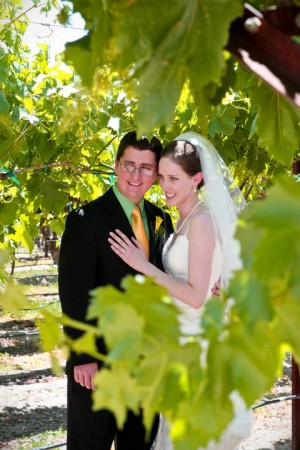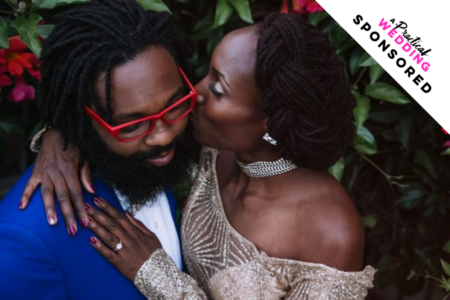On last week’s survey, a lot of you commented that you wished that we had more male voices on this site, and y’all, ME TOO. I am, however, not a man, so there is only so much I can do on this front (someone even told me there should be more male commenters, which, you know, I’m powerless over! Though I concur! Men, please comment, thank you). So I’m beyond delighted that today’s wedding graduate post comes in two parts. The first part is Emily, the second part is her husband Weston. Emily covers the emotions of it all, and Weston covers calming it down. I love (love, love) the balance of that message. So without further ado, I bring you Emily’s side of the story:
I had the incredible good fortune to stumble across APW during my wedding planning, and the biggest message I took from it was: there is another way. When Weston and I first got engaged, I heard so many (unintentional, I think) threats and warnings. “Get ready to spend a fortune.” “Do you really have time to plan a wedding right now? It’s basically a full-time job.” Then people started asking about the “details.” What flowers/colors/bridesmaids dresses/quirky-and-original items (photo booth, place settings, candy table, you name it) would we pick? How would I make it “my day”? I got panicky just thinking about it, and browsing through wedding blogs filled with beautiful pictures of things we didn’t want to spend money on and would never have the skills or desire to replicate made me sick to my stomach.
We must have had a dozen conversations where I threatened to elope, but it turns out you can’t elope without the other person’s consent. Weston had this whole spiel about the wedding being a commitment we make in front of our community, and how you need your community’s support in marriage, so really everyone at the wedding was a necessary participant… and of course he was right.
But then came the hardest part for me. I simply did. Not. Care about most of the planning. Or at least the planning that everyone asks you about – the flowers, the food, the invitation font, etc. I cared a lot about planning the ceremony, and we spent a great deal of our time talking about what the wedding meant (answer: the first day of marriage, the public statement of a lifelong commitment, a celebration with our community) and how the ceremony and the rest of the day should reflect those meanings.
The best part of wedding planning, hands down, was the time we got to spend discussing these issues with each other, our parents and in-laws, and our pastor. But everything else, all the details and the supposedly “fun stuff” that every little girl dreams about (so that was my problem – I didn’t start planning when I was five!)… I just had no interest in it. I am not a creative person, I have no desire to DIY, flowers mean nothing to me… seriously, I spent the whole meeting with our florist asking why we had to have bouquets. I still don’t understand the reason.
(Note: I am not saying there’s anything wrong with people who do care about these things, or who want to DIY/DIT and/or spend money to make things beautiful. It’s just that that wasn’t me, and I felt for a while that I was defective as a bride and as a woman because those things didn’t excite me.)
Enter a simple solution: Schedule your wedding so that you have another major(ish) life event, trip, whatever, in the week before your wedding. For us, it was my law school graduation, 3000 miles away and two days before the wedding. (Yeah, don’t even ask why we thought it was a good idea… we wanted to get married before I started studying for the Bar, and once we made sure our families and bridal party could make it, that was the only day that worked.) Turned out to be the best idea ever. Why? We had a built-in excuse for why we couldn’t throw a more elaborate wedding. Anything that required work in the week before the wedding was automatically vetoed, as was everything we couldn’t do from a distance (I lived in Boston; Weston lived in Sacramento; the wedding was in Fresno) or hand over to my parents. It freed us up from guilt and regret about how simple our wedding was, or how little work we were doing on it.
Okay, so the simpler way would have been to just ditch the guilt and regret, and realize we didn’t need an excuse for having an easy wedding. What did I really think was going to happen? Our friends and family would judge us for not having matching bridesmaids dresses, a cake, or a bouquet toss? They would be mad at us for making them travel to Fresno in the summertime (admittedly not the best destination wedding) for a plain, relatively casual, but joyous event? Of course not. They came ready to celebrate, and we had a blast.
It’s not like we showed up and the wedding just happened. Honestly, we probably didn’t do that much less than anyone else; it was more a matter of feeling like we were allowed to say no. I think there are two extremes for dealing with the WIC: trying to measure up to its “perfection,” or rebelling against the whole idea and refusing to do any of it. You can find the happy medium by really examining what you want to do, doing only that, and not even thinking about how the final product would rate, because there is no metric when it comes to having a joyful, loving celebration. An added bonus for me in having this attitude was that it was much easier to cede control and delegate tasks to my creative friends and family because they could just run with it, without waiting for uncreative me to worry about whether the invitations, programs, and centerpieces would conform to some unifying vision or theme.
Another hard thing about wedding planning (especially for “indie brides”) is avoiding the temptation to make your wedding unique, to put your stamp on every detail. While it’s reasonable to not want to be a cookie cutter bride, guess what? Getting married is not a new thing. The odds are that your wedding will not revolutionize the practice. That’s what’s so cool about weddings – you’re following in a tradition that billions of others have gone through. Even if you write your own vows or dance down the aisle, you’re still participating in one of the world’s oldest celebrations of love. You’re bringing two families together, and forming a new family. You can dress it up all you want with personalized touches (and if you have the ability to do so, go for it), but what you and the people who love you will take away from the day will be the same no matter what: you and your husband started a new life together, and it was awesomely happy.
In giving up on perfection and uniqueness, we ended up including some of the traditional or challenging things I swore I would never do. When I wasn’t measuring my wedding against “blog-worthy” weddings, it didn’t seem so important to shun placecards altogether (and thus avoid falling short of perfection). I could just do whatever I wanted for placecards, even something cutesy (I’m totally proud of this: folded-over paint color chips with the names written on them), but without caring whether it was good enough. Our wedding ended up being truly beautiful, but that was beside the point. We said “I do,” in front of our friends and family, and everything beyond that was just icing on the chocolate-covered strawberries. (Because really, who needs a fancy cake?)
Photos By: Evan Chung













